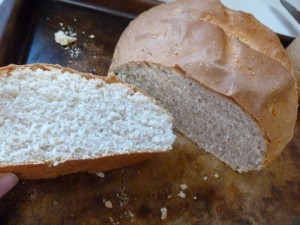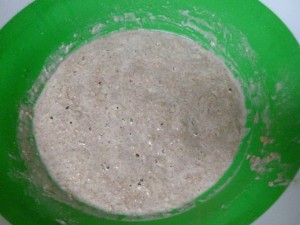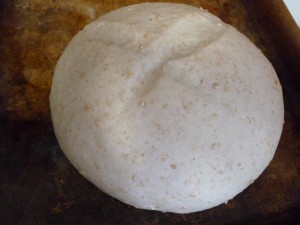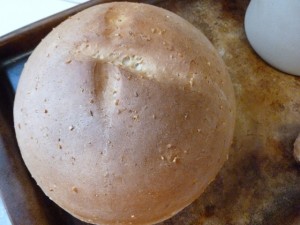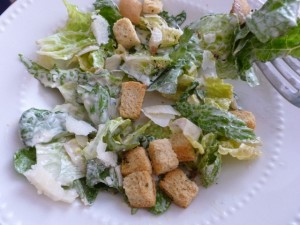Our Daring Bakers Host for December 2011 was Jessica of My Recipe Project and she showed us how fun it is to create Sour Dough bread in our own kitchens! She provided us with Sour Dough recipes from Bread Matters by AndrewWhitley as well as delicious recipes to use our Sour Dough bread in from Tonia George’s Things on Toast and Canteen’s Great British Food!
I thought it was a fun project, however I did not enjoy the taste of this sour dough as much as I have with other recipes. Sourdough is always fun to make it. Sourdough starts with a ‘starter’ or ‘leaven’, basically a flour and water dough that is fermented over 4 or more days. The older your starter, the more flavourful your bread will be. This is because the lactobacilli in the dough help digest the flour, adding the strong, sour flavour and making it more digestible; kind of like yoghurt. I know of people that have their start for years and it is always delicious to taste what we can make with it. I have yet to keep my starter for that long, but who knows, someday…
French Country Bread Servings: 1 large loaf plus extra wheat starter for further baking
Wheat Starter – Day 1:
4 1/2 tablespoons stoneground breadmaking whole-wheat or graham flour
3 tablespoons water
Total scant ½ cup
Directions: 1. In a Tupperware or plastic container, mix the flour and water into a paste. 2. Set the lid on top gently, cover with a plastic bag, to prevent messes in case it grows more than expected! 3. Set somewhere warm (around 86 F if possible). I sometimes put mine on a windowsill near a radiator, but even if it’s not that warm, you’ll still get a starter going – it might just take longer.
Wheat Starter – Day 2:
4 1/2 tablespoons stoneground breadmaking whole-wheat or graham flour
3 tablespoons water
scant 1/2 cup starter from Day 1
Directions: 1. Stir the flour and water into the mixture from Day 1, cover, and return to its warm place.
Wheat Starter – Day 3:
4 1/2 tablespoons stoneground breadmaking whole-wheat or graham flour
4 teaspoons water
scant 1 cup starter from Day 2
Total 1⅓ cup
Directions: 1. Stir the flour and water into the mixture from Day 2, cover, and return to its warm place.
Wheat Starter – Day 4:
3/4 cup plus 1½ tablespoons unbleached all-purpose flour
1/2 cup less 4 teaspoons water
1⅓ cup starter from Day 3
Total scant 2⅔ cup (625 ml) (440 gm/15½ oz)
Directions: 1. Stir the flour and water into the mixture from Day 3, cover, and return to its warm place. At this point it should be bubbling and smell yeasty. If not, repeat this process for a further day or so until it is!
Stage 1: Refreshing the leaven
1 cup less 1 tablespoon wheat Leaven Starter
6 tablespoons less 1 teaspoon stoneground bread making whole-wheat or graham flour
1 cup plus 2 teaspoons unbleached all purpose flour
1/2 cup water
Production Leaven Total 2¾ cups plus 4 teaspoons
Directions: 1. Mix everything into a sloppy dough. It may be fairly stiff at this stage. Cover and set aside for 4 hours, until bubbling and expanded slightly.
Stage 2: Making the final dough
3/4 cup less 1 teaspoon stoneground breadmaking whole-wheat or graham flour, plus more for dustin0g
2 cups plus 2 tablespoons unbleached all-purpose flour
1¼ teaspoons sea salt or ⅔ teaspoon table salt
1 ¼ cups water 1
¾ cups production leaven – this should leave some (1 cup) for your next loaf.
Total 6 cups less 2 tablespoons
Directions: 1. Mix the dough with all the ingredients except the production leaven. It will be a soft dough. 2. Knead on an UNFLOURED surface for about 8-10 minutes, getting the tips of your fingers wet if you need to. You can use dough scrapers to stretch and fold the dough at this stage, or air knead if you prefer. Basically, you want to stretch the dough and fold it over itself repeatedly until you have a smoother, more elastic dough. Smooth your dough into a circle, then scoop your production leaven into the centre. You want to fold the edges of the dough up to incorporate the leaven, but this might be a messy process. Knead for a couple minutes until the leaven is fully incorporated in the dough. Spread some water on a clean bit of your work surface and lay the dough on top. Cover with an upturned bowl, lining the rim of the bowl with a bit of water. Leave for an hour, so that the gluten can develop and the yeasts can begin to aerate the dough. Once your dough has rested, you can begin to stretch and fold it. Using wet hands and a dough scraper, stretch the dough away from you as far as you can without breaking it and fold it back in on itself. Repeat this in each direction, to the right, towards you, and to the left. This will help create a more ‘vertical’ dough, ready for proofing. Heavily flour a banneton/proofing basket with whole wheat flour and rest your dough, seam side up, in the basket. Put the basket in a large plastic bag, inflate it, and seal it. Set aside somewhere warm for 3-5 hours, or until it has expanded a fair bit. It is ready to bake when the dough responds to a gently poke by slowly pressing back to shape.
Preheat the oven to hot 425°F. Line a baking sheet with parchment, then carefully invert the dough onto the sheet. I like to put the baking sheet on top of the basket, then gently flip it over so as to disturb the dough as little as possible. Make 2-3 cuts on top of the loaf and bake for 40-50 minutes, reducing the temperature to moderately hot 400°F 6 after 10 minutes. Cool on a cooling rack.









